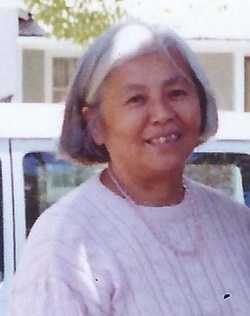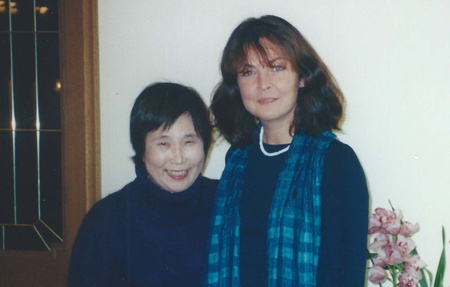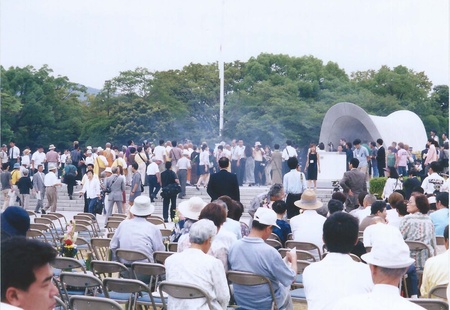What do we know about Hiroshima? And when and how do we learn it?
For me, the answer came from my great aunt, Mary Hamaji, a Nisei peace activist in Berkeley, who went to the bombed-out city with the American Occupation in 1946.
As a young woman, Auntie Mary was incarcerated in a camp in Jerome, Arkansas during the war. Once the war was over, she decided she wanted to see the world and signed up to join the Occupation to help rebuild Japan. She started in Tokyo, then went to work with the Atomic Bomb Casualty Commission (ABCC) in Hiroshima and Nagasaki. At the time, news and images were already censored, so it must have been a shock to see thirteen square miles of a city reduced to ash with nothing but three or four concrete shells of buildings left standing. But it was the people, not the infrastructure, that changed her life. And even though I didn’t know her well – in fact I only spoke with her a few times – she also changed my own.
She gave me a vision
My mother remembers hiding from the “crazy peace people” in the living room with Auntie Mary when she was a child visiting her cousins. Mary’s own children remember joining the Peace Marches in Berkeley while they were in strollers, or at least old enough to cling to them, or to cling to the high hand of their angry and determined mother as the people on the sidewalks screamed “Commie go home.” They remember the anti-nuke meetings, the visit from the Hiroshima “maidens” – young, crippled, disfigured women who were sponsored by the Quakers to endure months of surgery to reduce their scars; they remember playing in the other room to avoid seeing rare footage of the wreckage that one of the anti-nukes got their hands on: even glimpsing it through a doorway would give Mary’s daughter nightmares for years.
But that was the aftermath. First, Mary was confronted with the effects of the bomb. The immediate survivors had suffered flash burns, fatal injury to their internal organs and radiation poisoning, but even people within three and a half kilometers of ground zero received heavy doses of radiation, even if they were not there when the bomb was dropped but came in after to search for missing loved ones. Death was not predictable. Severely injured people managed to survive. People who drank the water died. Seemly healthy people suddenly fell ill, developing black mouths, purple spots, losing their hair in clumps. Dying.
Auntie Mary was a file clerk at the ABCC, working with a group of American doctors. Since she spoke Japanese, she was also a sometime interpreter, asked to join them in their shiny black cars as they went house to house, visiting mothers of stillborn babies. It was her job to ask the grieving mothers for the details, like where they were when the bomb dropped. To ask for the bodies of their dead babies.
She thought they were helping. With all the devastation around her, and all the confusion and despair in people who didn’t know what was happening, medical care was the number one priority. But it turned out that medical care was not what she was offering. The ABCC was studying the enemy, trying to measure what their bomb did to the body, given differences in distance, shielding, exposure, age, gender and the like. The people who were being brought to the clinics got no help. No treatment.
That’s when Auntie Mary’s outrage truly began.
She gave me an idea
When I finally decided I needed to know more about what happened in Hiroshima, I started here, in America. An organization call Friends of Hibakusha in San Francisco was helping Japanese American survivors get medical care and was conducting interviews with them about their experiences. I met with them, and a whole new world opened up for me in their stories. In particular, I found several people who, like Auntie Mary, were imprisoned in American incarceration camps and ended up in Japan, but these people were “sent back” on exchange ships while the war was in progress and were there when the bomb was dropped. They spoke of their confusion about being American but being stripped of their US citizenship because they looked Japanese. Of being discriminated against, even having rocks thrown at them, in Japan for acting like Americans. Where and how to fit in when nobody wants you? When the outside and the inside don’t match?
In several of the stories, young Nisei girls talked about being conscripted by the Japanese military and forced to work as radio operatives, intercepting and translating Allied broadcasts. They were teenagers, without rights or country. There are very few of these accounts, since the atomic bomb was dropped almost directly over the building where they worked. I found another account in a book by Rinjirō Sodei called Were We the Enemy?
A story was building in my head. As a novelist, I look for character, and I began to find one in the story of Hiroshima told through Japanese-American eyes. I traveled to Japan in search of this character, and lived there for six months, researching the bomb. Living in Hiroshima, I got huge support from the Hiroshima Interpreters for Peace, a volunteer guide organization founded by Keiko Ogura that helped put me in touch with survivors. They became my friends and family while I lived away from home for six months. I was also introduced to Marie Tsuruda through a roundabout connection: my mother-in-law’s friend’s ex-boss. By coincidence, Marie was also held in an incarceration camp in Arkansas as a young girl. By even more coincidence, she turned out to be the sister of two of the women I had found in my research who were becoming my inspiration for a main character in my novel, Shadow Child, which was finally published this year.
She gave me a voice
On this 73rd anniversary of the Hiroshima bombing, my friends from the Hiroshima Interpreters for Peace will meet at the Peace Park for a morning ceremony, and in the evening they will float lanterns on the Motoyasu river to commemorate the dead. In between, they will do interviews and talk to students and tourists about what happened that terrible day. They will do their best to make sure that the deaths of some 200,000 people were not in vain. They will try to remind the world of what the bomb looked like, and what it did. They are more peaceful than my great aunt was when I met her. But in both countries, the healing is not complete.
Mary Hamaji planted a seed in me, and the Japanese American hibakusha I discovered along the way continued to water it. It is the seed of confusion. It is the seed of not belonging, of being a misfit, of needing to define yourself in defiance of the prejudices of the world. Key among their questions: Who am I? What do I believe? In particular, these people do not have the luxury of understanding the two atomic bombs from a place of citizenship. Most Americans still believe President Truman’s claim that the bomb was necessary to end the war, that it was dropped on a military city to spare civilian lives, that it was a great scientific marvel, and a “powerful and forceful influence” for world peace. But Japanese Americans, incarcerated and bomb-affected, don’t need censored archives to tell them these are lies and excuses. They have experienced the cruelty and racism of America firsthand, and they know: there were no good guys.
And still, a personal courage grows in the rupture. For Auntie Mary, a peace activist in Berkeley, warning the world about nuclear weapons became her life. She protested American racism and aggression and our lies, but she did not give up on America. She knew this country in our failings and fought for us to be greater and better than before. That is the essence I tried to capture in my novel. Of resilience, and truth-telling, in the face of horror. And of a personal quest to make a better world.
© 2018 Rahna Reiko Rizzuto








